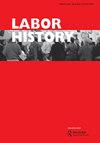The revolutionary left in Comisiones Obreras: an introduction
IF 0.7
4区 管理学
Q1 HISTORY
引用次数: 0
Abstract
ABSTRACT This text introduces the readers of Labor History to the set of articles that make up the special issue entitled ‘Radical projects in the Comisiones Obreras (1958–1991)’. Through this collective work we aspire to outline the global dynamics that the revolutionary left developed in relation to Comisiones Obreras (CCOO) first as a socio-political movement, and later as a trade union confederation. In this way, we offer a general context to better understand the actions carried out by the militants of these organizations. In view of their decisions, we have classified this phenomenon into three major phases that allow us to understand the forgotten history of alternative projects within the trade union. The main lesson of this special issue is that the various strategies did not follow the same historical transformations and yielded different outcomes.《奥布拉斯委员会》中的革命左派:导论
本文向《劳动史》的读者介绍了一组文章,这些文章构成了题为“委员会中的激进项目(1958-1991)”的特刊。通过这一集体工作,我们渴望勾勒出革命左翼首先作为一个社会政治运动,后来作为一个工会联盟而发展起来的全球动态。通过这种方式,我们提供了一个总的背景,以便更好地了解这些组织的武装分子所采取的行动。鉴于他们的决定,我们将这一现象分为三个主要阶段,使我们能够了解工会内部替代项目被遗忘的历史。本期特刊给我们的主要教训是,各种战略并没有遵循相同的历史转型,产生了不同的结果。
本文章由计算机程序翻译,如有差异,请以英文原文为准。
求助全文
约1分钟内获得全文
求助全文
来源期刊

Labor History
Multiple-
CiteScore
1.00
自引率
28.60%
发文量
44
期刊介绍:
Labor History is the pre-eminent journal for historical scholarship on labor. It is thoroughly ecumenical in its approach and showcases the work of labor historians, industrial relations scholars, labor economists, political scientists, sociologists, social movement theorists, business scholars and all others who write about labor issues. Labor History is also committed to geographical and chronological breadth. It publishes work on labor in the US and all other areas of the world. It is concerned with questions of labor in every time period, from the eighteenth century to contemporary events. Labor History provides a forum for all labor scholars, thus helping to bind together a large but fragmented area of study. By embracing all disciplines, time frames and locales, Labor History is the flagship journal of the entire field. All research articles published in the journal have undergone rigorous peer review, based on initial editor screening and refereeing by at least two anonymous referees.
 求助内容:
求助内容: 应助结果提醒方式:
应助结果提醒方式:


